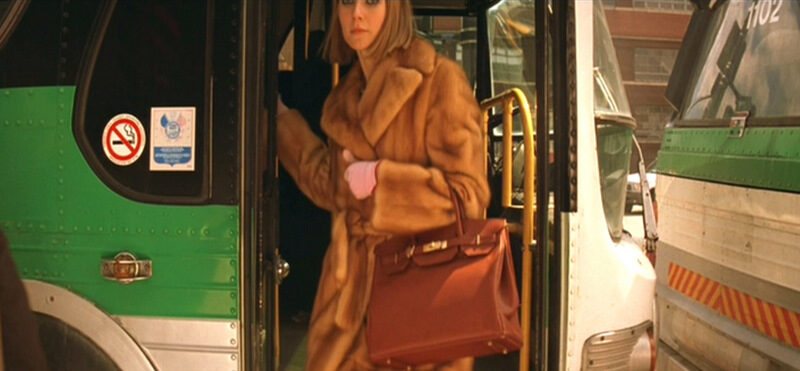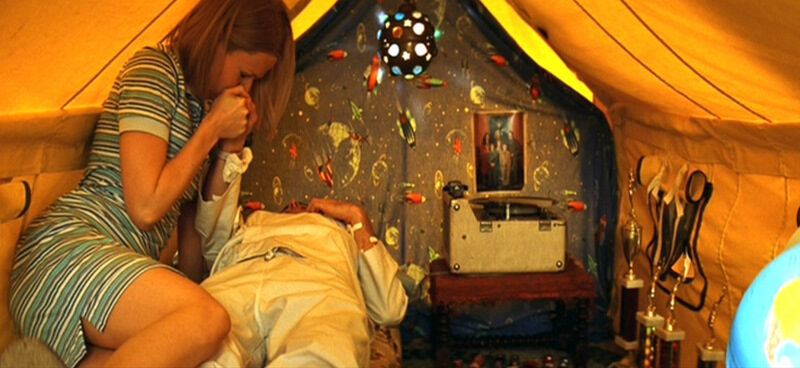The Royal Tenenbaums: Gwyneth Paltrow’s Tennis Dress | Clothes on Film

Gwyneth Paltrow is an external rather than internal actress, meaning she has a sponge like ability to soak up characterisation through dress, make up and hair. She is, first and foremost, how she looks.
In playing literary prodigy Margot Tenenbaum in The Royal Tenenbaums (2001), Gwyneth adopted a sultry bohemian vibe (apparently based on sixties fashion model Nico) that she was not then remotely known for in real life. Whatever emotional connection she brought to the part, her performance was defined by her clothes.
“As soon as I knew I was wearing the little Lacoste dresses and loafers and a fur coat, I said to myself, okay, I get it. It became pretty clear to me who Margot was.”
Gwyneth may not have dressed like Margot back then, but she knew who did.
Light blue, white and purple striped cotton tennis dress with piqué collar by Lacoste. Toffee coloured wrap-over mink fur coat, belted, with wide pointed lapels by Fendi. Dark brown loafers. Brown leather ‘Birkin’ bag by Hermès.
Also: red, brown and orange striped variation on the dress; pink cotton gloves, nude chemise and red plastic hair slide.
For director of The Royal Tenenbaums, Wes Anderson, a heightened visual reality helped define his characters: clothes, house, cars, technology, everything in the film is identifiable as being from a specific era. Just like her siblings, Margot is stuck as a child; still wearing exactly the same clothes. She peaked as an adolescent and never progressed any further.
Royal Tenenbaum (Gene Hackman) too, once a man of means before losing it all to his own son, squeezes into a double-breasted pinstriped suit and thick rimmed spectacles from the 1970s. For him this was a time of his greatest triumphs, and sacrifices (as he clumsily informs the Tenenbaum children when announcing his divorce from their mother). The characters occupy an alternate reality. It’s our world, but theirs’.
Costume designer Karen Patch had already collaborated with Anderson on his debut picture Bottle Rocket (1996) and Rushmore (1998), so by The Royal Tenenbaums in ’01 she completely understood the inherent irony in his work. Margot wearing the tennis dress, for example, not only is there direct connotation with her ex-tennis ace brother Ritchie (Luke Wilson), but also the aesthetic joke of placing a genius in an outfit deliberately set to undermine her intelligence.
In the 1970s, now defunct BEA introduced short red tennis dresses as uniform for its stewardesses. Like so many airlines of the era they chose to undermine their staff by encouraging their objectification. Margot, despite her promiscuity, would hate to be sexualised in this way, and yet, arguably, this is exactly what has happened.
René ‘the Crocodile’ Lacoste wore his famous piqué polo shirt for the first time on a tennis court in 1927. By 1933 he was persuaded to add the stitched croc emblem and market his shirt to the public and it was an instant hit. In the early 1950s he teamed up with Izod owner David Crysta, someone primarily known for women’s suits and sportswear, to form Izod Lacoste.
Throughout the sixties Crystal designed a series of tennis dresses based on the piqué shirt for U.S. department stores including, amongst others, Saks and Niemen Marcus. He also used the croc logo for his Haymaker brand.
Gwyneth wears a dress similar to one from this period, or even slightly earlier. Many also had zips along the front and a fold-down collar. The style underwent resurgence during the mid-1990s, and some of those found in thrift shops today are retro revivals and not Izod Lacoste originals.
Margot’s luxurious mink fur coat was custom made by Italian leather specialists Fendi. Evidently her look is accessibly indie, if not affordably so.
Through Margot, Gwyneth Paltrow became a middle-class fashion icon. Those in search of hippie chic on a designer budget could emulate her look and call it nonconformist. If haute couture can never really claim to be all that alternative, Margot remains as close as it will ever get.
Read more about Wes Anderson’s work at The Rushmore Academy.
© 2010 – 2012, Chris Laverty.





